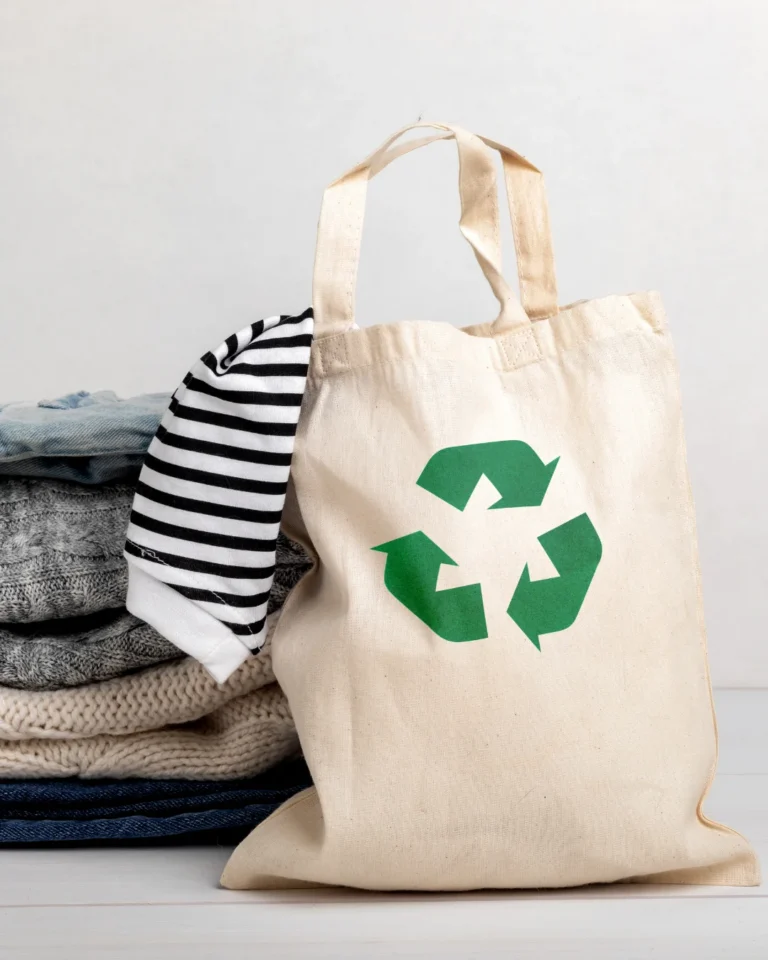SKL is reader supported. When you buy through links on our site, we may earn affiliate commission. Learn more here.
As one of Europe’s prominent fashion retailers, you may be wondering just how sustainable Primark is. It claims to be the UK’s largest fashion retailer by volume.
When a brand produces as much clothing at the low prices Primark boasts of, it’s important to look into the practices and ethics of that business model.
Where Did Primark Originate From?
Primark originated as Penneys in Ireland in 1969, but due to trademark conflicts with J.C. Penney, it operates as Primark internationally.
The retailer is owned by Associated British Foods (AFB). Their parent company mainly focuses on grocery and agriculture-related businesses, making Primark an outlier in ABF’s portfolio.
Primark currently operates 410 stores in 15 countries (primarily in the UK, Ireland, and mainland Europe), but they are working to expand to 530 stores by 2026 with the US being the main target of their growth plans. Their current market value sits at $9.89 billion.
Incredibly, Primark has found this success without e-commerce. Primark doesn’t sell their clothes online, but they do offer a website that allows customers to browse offerings and see stock availability in nearby stores.
They have trialed a buy-online-pick-up-in-store model in the UK but remain resistant to fully embracing e-commerce to maintain their margins and low prices by saving the logistics costs of online selling.
Third-party businesses have attempted to remedy this absence of online shopping by selling Primark via Amazon, but Primark issued a warning that this may result in customers paying more since Primark doesn’t sell on Amazon directly, and those doing so will be reselling their products at a markup.
In an era of online everything, Primark’s success without online shopping feels counter-intuitive and many wonder if it can last.
With Primark’s razor-thin margins, they can’t sustain the costs of in-store selling along with the added costs of online selling. These low prices and thin margins beg an ethical question we will dig into below.
Is Primark fast fashion?

As we’ve explored before, fast fashion is the business model of making high volumes of clothing quickly and at a low cost. Achieving speed and low prices at volume is only possible by pushing garment workers to the limits, underpaying them, and cutting corners.
You can identify fast fashion companies by cheap pricing (though some brands manufacture at low costs but price much higher), constant new releases, urgency-based marketing, and being trend-led to encourage repeated (over) consumption.
Based on Primark’s resistance to online selling due to low prices with thin margins, we can already gather that Primark checks the cheap, harmful manufacturing fast fashion check box.
They also claim to be the largest UK retailer by volume, so we know that overproduction and making a lot of cheap clothing is inherent to their model— another indicator that Primark qualifies as fast fashion.
What makes Primark a bit different than other brands is that it doesn’t focus as much on advertising, allowing the low prices to do the work of drawing customers and encouraging sales in bulk.
Without paying for the logistics of online selling and advertising, Primark prices its products even lower than fellow fast-fashion competitors like H&M.
This leads to the customer buying more items because the low price allows shoppers to justify adding more to their (literal) shopping cart. It plays into the mindset of a deal. Look how much I could buy for just $30!
This bulk production of cheap clothes is enough for us to readily categorize Primark as fast fashion. But what about their sustainability claims and practices?
Is Primark Ethical and Sustainable?
In this time when climate is front of mind, every brand is under pressure to have some sort of sustainability reporting and target setting. Therefore, it’s no surprise that fast fashion brands like H&M and Primark have sustainability initiatives.

“Primark Cares”
Primark formally launched their sustainability strategy Primark Cares in September 2021. Unfortunately, a glance at Primark’s sustainable commitments reveals that much of their communication lacks real weight with vague goals, no science-based targets, and very little data or benchmarks that allow their progress to be traced.
Their meager one-page corporate environmental policy does not include a single measurable goal, only ambiguous promises to “reduce” and “improve.”
For example, when it comes to sourcing, they state, “We will aim to buy materials and products from more sustainable and traceable sources in our supply chain. We will consider the environmental impact of materials and products in the procurement of goods and services for our business operations.” This statement is so vague that it means nothing. What defines a sustainable material or source for Primark? What impact are they measuring and looking to avoid? They don’t say.
While their 2021/2022 sustainability report does offer a bit more specifics on goals and benchmarks, implementation strategies are still lacking. Fashion Revolution’s 2023 Transparency Index scores the brand a 40 out of 100. While they did receive a high score (89/100) for publicly disclosing commitments, they received a 15/100 for their supply chain traceability.
If brands don’t provide meaningful ways to track and see into their supply chains, it’s tough to understand if any merit or progress is being made on their commitments.
Primark’s Sustainability Targets
One of their goals is to halve carbon emissions by 2030. However, their report indicates that their emissions have increased by 2.6% from their baseline year due to increased material and product volume. With Primark’s plan to add over 100 new store locations in the next few years, this emissions figure will surely continue to increase.
To Primark’s credit, they do partner with several sustainable fashion organizations and businesses to support their initiatives. A glance through their sustainability reporting may leave a reader thinking that their policies and partnerships are fairly robust (once you read far enough past the vague claims on the corporate site).
But, just because policies and standards are stated doesn’t mean they are being implemented and followed up on. Primark does little to help us see the follow-through from them. One could even posit that they rely too heavily on their partnerships to create a false sense of confidence in their efforts.
Despite being a part of ETI (Ethical Trading Initiative), the Sustainable Apparel Coalition, the United Nation’s Fashion Charter, ACT (Action, Collaboration, Transformation on Living Wages), and beyond, Primark falls short of making it clear whether their workers are truly paid a living wage, whether it acts responsibly in relationship to suppliers, or meeting Fair Labor Association standards when it comes to a minimum working age.
Primark’s “Sustainable Materials”

Primark’s main “sustainable materials” seem to be cotton and recycled materials like recycled polyester, nylon, and acrylic which pose their own set of sustainability dilemmas.
They claim that cotton could be found in more than half of their clothes. However many clothes are produced with blends, and while cotton may be found in 50% of their products, we don’t know how much cotton makes up the overall fabric content.
Plus, recycled fibers and blended fabrics create increased barriers to textile recycling, impacting a garment’s circular potential. Primark fails to offer much current data or traceable strategies. Without this transparency, accountability doesn’t exist.
Primark’s “Sustainable Cotton Program”
Primark touts their Sustainable Cotton Program which partners with CottonConnect to support farmers to farm with “more regenerative” methods. Primark has the goal of ensuring all of the cotton used in their supply chain is “organic, recycled or sourced from our Sustainable Cotton Programme.” The key word in this statement is or.
They are careful not to claim that the cotton in their own program is organic. But they continually make vague claims that this program is about regenerative farming without clearly defining what that means.
Adopting an organic approach would lend itself to the bigger picture of regenerative farming as it eliminates genetic modification and pesticide use and prioritizes land health.
Yet, it appears that Primark isn’t interested in producing their own organic cotton (which is known for a lower yield and higher cost) because they list the goal of their program “to encourage lower input costs and higher yields,” which seems more in alignment with Primark getting to make more clothes for less cost rather than pursuing a truly sustainable solution.
Primark’s Factories

Primark is quick to mention that they don’t own any of the factories their clothing is made in. This is largely a tactic to divert responsibility should they be called into question.
While they do require suppliers to sign a code of conduct, this doesn’t guarantee the code is met and upheld. They doe not publish their factory audits, and their latest performance report based on factory audits reveal that a vast majority of sites audited didn’t meet full ethical compliance, with 41% of sites having significant issues reported.
Primark & The Rana Plaza
Primark has been no stranger to ethical and worker rights complaints. Most notably, Primark was one of the brands being produced in the Rana Plaza garment factories in Bangladesh that collapsed in 2013 and killed over 1,100 people and injured thousands more.
This catastrophic event is considered the worst industrial tragedy in fashion and the fourth-largest industrial tragedy in history. It was largely preventable as it was a result of poor working conditions and negligence.
In the aftermath of Rana Plaza, the Bangladesh Accord was a landmark agreement created to address safety in garment factories. Primark was one of the 200+ brands that signed the original Accord and its latest version.
Several years before the Rana Plaza collapse, Primark was facing criticism for horrendous and illegal working conditions, including forced overtime, late payments, and verbal and physical abuse.
A 2019 Christian Initiative Romero report interviewed workers of 6 factories that supplied Primark and found that none of those factories met Primark’s code of conduct and some were even in breach of the local law surrounding working hours and minimum wage.
Similarly, Labour Behind the Label’s 2019 Tailored Wage report found no evidence that Primark paid their workers a living wage. Additionally, they were found to be participating in wage theft during the pandemic.
This was your full guide to Primark’s Sustainability Claims.
While Primark seems to be making a lot of claims and commitments that sound pretty good, there is little evidence that they are truly living up to the claims.
With a litany of supply chain and worker abuses, questionable efforts to improve material sourcing, and an unwavering commitment to grow and keep costs unreasonably low, Primark cannot be considered a sustainable or ethical brand.
Remake’s Accountability Report puts it best, Primark’s “current business model is not compatible with any definition of sustainability, so unless it pivots its focus away from exponentially increasing its production of cheap, poor-quality clothing, any positive advancements it makes will likely be overridden by its focus on output growth.”
Avoid Primark and check out these more ethical, affordable brands instead.
If you enjoyed this article, check out these other community favorites below!
 Enter To Win Over $1500+ In Non-Toxic Goodies!
Enter To Win Over $1500+ In Non-Toxic Goodies! 







